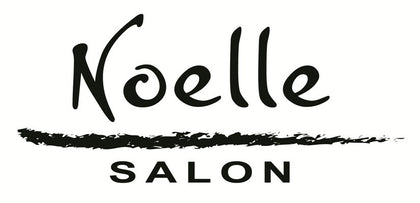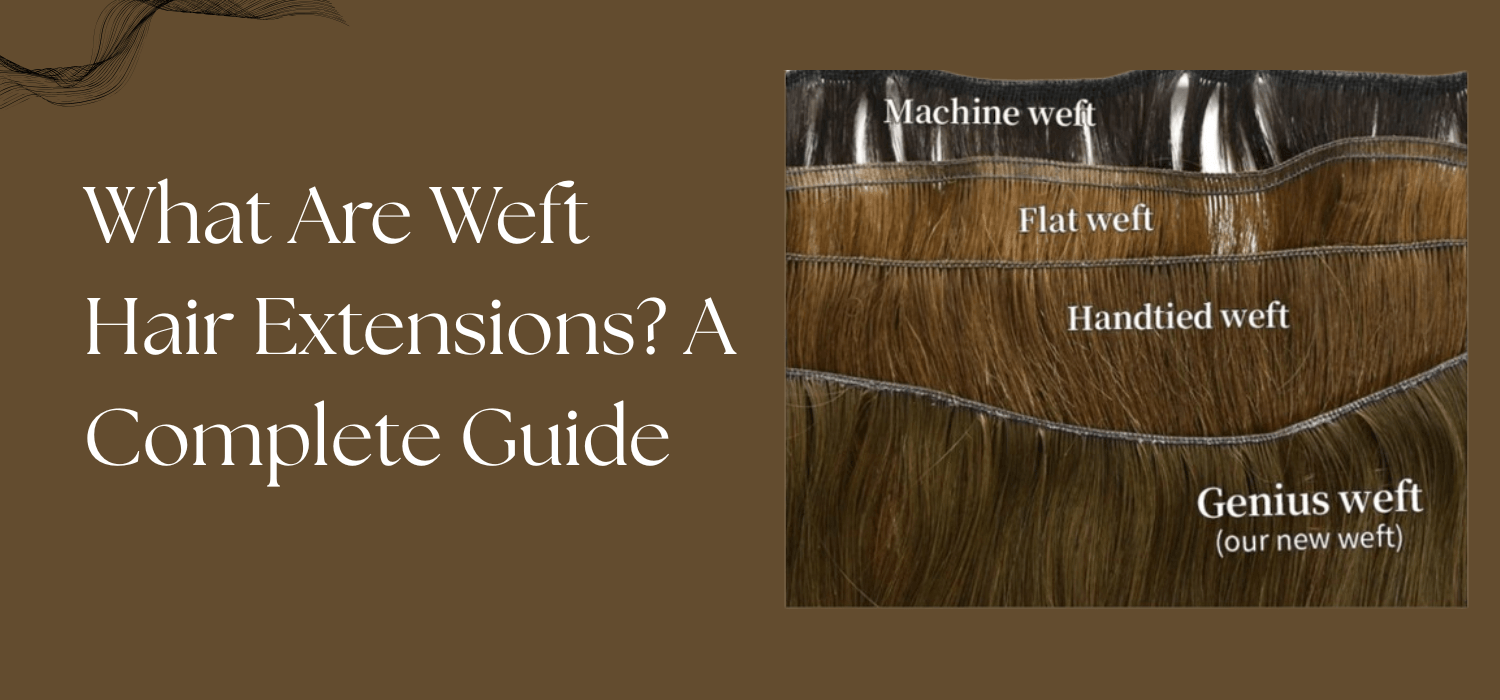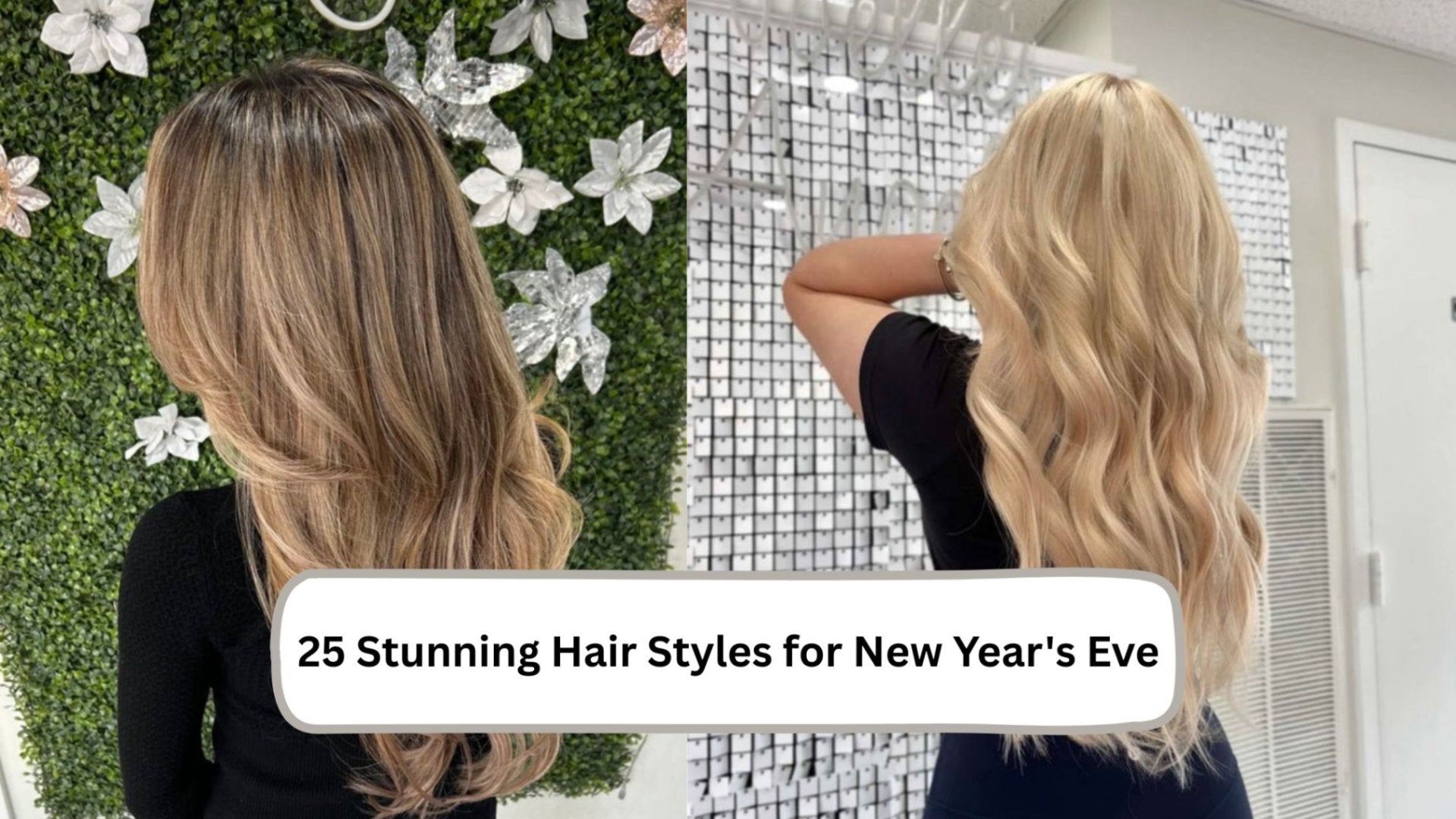What Are Weft Hair Extensions? A Complete Guide
Key Highlights
-
Weft hair extensions are stitched tracks that add instant length and volume.
-
Options include hand-tied, machine, hybrid, genius, and volume wefts.
-
Installation involves consultation, sectioning, anchoring, blending, and aftercare.
-
Each install lasts 6–10 weeks, with quality hair reusable for months.
-
Prices range from $200 to $900+, depending on type and method.
-
The best weft depends on your hair type, lifestyle, and budget.
Noticing your ponytail feels thinner than it used to? Or maybe your hair refuses to grow past your shoulders, no matter how patient you are. You're not alone. Many people deal with hair that looks flat, lifeless, or stubbornly short.
Styling then becomes frustrating. Hours of teasing, spraying, or curling often lead to the same thin result. That's why so many turn to extensions for a boost of volume and length.
Among the options, weft hair extensions are a favorite. They add natural fullness and length without weighing your hair down.
In this blog, we'll cover what weft extensions are, the different types, their lifespan, pros and cons, costs, and safe ways to wear them.
What Is A Weft Hair Extension?
Think of a weft as a curtain of hair. Each strand is stitched together at the top to form a "track," which sits close to your scalp. One piece, and suddenly your hair has volume and length without dozens of tiny bonds.
Here's where it gets interesting. Wefts aren't one-size-fits-all. They come in two main types: synthetic and human hair. Synthetic is the budget pick, great for quick style changes. Human hairpieces are the real deal. They're softer, more natural, and you can curl, straighten, or style them just as you would your own.
Even better, you get options in how they're applied. Sew them in, bead them in, or bond them. Choose whatever fits your lifestyle and comfort. That's what makes weft extensions one of the most versatile choices out there.
What Types Of Weft Are Available?
Think all wefts do the same thing? Not even close. Some blend in quietly, others turn up the volume. Finding the right one makes all the difference.
1. Hand-Tied Wefts

These are lightweight and thin, which makes them a favorite for clients with fine or fragile hair. Since they lie flat against the scalp, they blend beautifully without looking bulky. The downside? They're delicate and can't be cut without unraveling, so they need an experienced stylist.
2. Machine Wefts

As the name suggests, these are sewn together by a machine. They're thicker and sturdier than hand-tied, which makes them an excellent match for medium to thick hair. If you're a gym rat, machine wefts can also be trimmed to size, giving stylists more flexibility. The added bulk, however, may not be as comfortable on fine hair.
3. Hybrid Wefts

Think of hybrids as the "best of both worlds." They combine the durability of machine wefts with the thin, flexible design of hand-tied. A common myth is that they're harder to wear, but they are actually easier to customize, reusable, and more comfortable to wear in the long term, which is why many salons consider them a go-to option.
4. Genius Wefts

A new innovation in extensions, Genius wefts are ultra-thin with no return hair or "beard" at the seam. This makes them nearly invisible and very comfortable to wear. They're strong enough to be cut without unraveling, offering maximum styling freedom while still blending seamlessly.
5. Volume Wefts

Designed to add major fullness in fewer rows, volume wefts are thicker at the seam and work best for clients who want bold, dramatic hair, resulting in better volume. They're not usually recommended for very fine hair, but they're ideal for creating a fuller look quickly.
The right weft sets the stage, but the real magic happens in how it's installed. Let's look at the process that brings your extensions to life.
How Are Weft Extensions Installed?

The weft hair extension installation follows a structured process to ensure they look natural, feel comfortable, and stay secure, providing a seamless blend with your own hair. While methods like sew-in, beaded, tape-in, or bonded wefts have their own variations, the overall steps are quite similar.
Step 1: Consultation And Preparation
Before anything goes in, your stylist checks the health and density of your natural hair. This step is crucial for selecting the right type of weft for your hair.
-
Talk through your goals, whether you want more length, volume, or both
-
Choose the right weft type (hand-tied, machine, hybrid, or tape)
-
Wash and dry hair thoroughly so the extensions attach securely
This step makes sure your hair is ready for safe installation.
Step 2: Sectioning The Hair
A clean foundation sets the tone for a seamless look.
-
Hair is divided into horizontal rows
-
Each section is clipped neatly out of the way
-
The number of rows depends on your hair's density and the look you want
Proper sectioning helps wefts sit flat and blend naturally.
Step 3: Measuring And Fitting The Wefts
Each weft is customized to fit the shape of your head.
-
Wefts are measured against each row
-
Longer tracks are trimmed to prevent overlap
-
Ends may be sealed to stop shedding
Sizing ensures the extensions feel comfortable and look balanced.
Step 4: Anchoring The Wefts
This is where methods differ; the anchoring technique changes how the extensions feel and how long they last.
-
Sewn-In (Weave): Wefts are stitched onto braided cornrows for a strong hold
-
Beaded/Invisible Bead (IBE): Beads form a track, and the weft is sewn on for a flat, seamless look
-
Micro/Nano Rings: Tiny beads attach small weft sections directly to strands of natural hair
-
Bonded/Glue: A professional adhesive secures the weft close to the scalp or natural hair
-
Tape-In Wefts: Sticky tape sandwiches natural hair between two wefts for a quick install
Choosing the right method depends on your hair type, lifestyle, and how long you plan to wear the extensions.
Step 5: Securing, Blending, And Styling
Once attached, the wefts are blended into your natural hair for a flawless finish.
-
Locks, beads, or stitches are tightened and secured
-
Extensions are trimmed and layered to blend seamlessly
-
Styling tools are used so your hair and extensions move naturally together
This is the step where the extensions stop looking like add-ons and start feeling like your own.
Step 6: Removal And Aftercare
Extensions aren't permanent, so safe removal and care are just as important as the install.
-
Sewn or beaded wefts: Threads or beads are loosened before gently sliding out the weft
-
Tape-in or bonded wefts: A professional solution is applied to dissolve the adhesive safely
-
Care tips: Brush gently, wash with sulfate-free products, and sleep in a loose braid to avoid tangles
With proper care, high-quality wefts can be reused across multiple installations.
At Noelle Salon, our stylists specialize in all major weft methods, including hand-tied, beaded sew-ins, and Genius wefts. With decades of experience and premium hair options, we make sure your extensions look seamless, feel comfortable, and protect the health of your natural hair. Book a free consultation and let our team match you with the right method.
How Long Do Weft Hair Extensions Last?
The longevity of weft hair extensions depends on the method, hair quality, and daily care. On average, an installation lasts 6 to 10 weeks before needing adjustment, and high-quality hair can be reused several times. Here’s a breakdown:
|
Type of Weft |
Lasts Per Installation |
Reusability |
Best For |
|---|---|---|---|
|
Hand-Tied Wefts |
6–8 weeks |
6–9 months |
Fine or thin hair |
|
Machine Wefts |
6–10 weeks |
9–12 months |
Medium to thick hair |
|
Hybrid/Genius Wefts |
8–10 weeks |
Up to 12 months |
Most hair types |
|
Volume Wefts |
6–8 weeks |
6–9 months |
Adding dramatic fullness |
|
Tape-In Wefts |
6–8 weeks |
3–4 reuses |
Quick installs, flat finish |
Several things determine whether your extensions last their full potential or need replacing sooner:
-
Maintenance Schedule: Move-ups every 6–8 weeks, keep rows tight.
-
Hair Quality: Premium Remy human hair holds up for multiple installs, and maintaining the hair’s pH is crucial for the longevity of your extensions.
-
Care Routine: Using sulfate-free products and avoiding harsh cleansers, gentle brushing, and protective styling at night helps extend the life of your hair.
-
Lifestyle Habits: Heat styling, swimming, or skipping salon visits can shorten wear time.
Most clients appreciate the noticeable difference they see in the weft hair extensions before and after look, which is evident throughout the entire installation cycle. With proper care, the same wefts can be reused for months, making them a smart long-term investment.
How Much Are Weft Hair Extensions?
The cost of weft hair extensions can vary widely depending on the type of weft, the amount of hair needed, and the installation method. On average, prices range from $200 to $900 or more, with premium options available for longer hair or specialty methods, which incur additional costs.
|
Type of Weft |
Average Price Range |
Maintenance Cost |
Long-Term Value |
|---|---|---|---|
|
Hand-Tied Wefts |
$300 – $800+ |
$100 – $200 per move-up |
High, reusable up to 9 months |
|
Machine Wefts |
$250 – $700+ |
$100 – $150 per move-up |
High, reusable up to 12 months |
|
Hybrid/Genius Wefts |
$400 – $900+ |
$150 – $250 per move-up |
Very high, lasts up to 12 months |
|
Volume Wefts |
$350 – $800+ |
$150 – $200 per move-up |
Good for fuller styles |
|
Tape-In Wefts |
$200 – $600+ |
$80 – $150 per reapplication |
Moderate, reusable 3–4 times |
Before deciding on extensions, it helps to understand what goes into the final cost:
-
Type of Weft: Hand-tied and Genius wefts are priced higher because of their thin, seamless design.
-
Amount of Hair: Adding more rows or longer lengths increases the price.
-
Installation Method: Sewn or beaded methods often incur higher costs due to the time and skill required for their implementation.
-
Maintenance: Regular move-ups every 6–8 weeks add to the total cost over time.
-
Stylist Expertise: Experienced extension specialists may charge more, but they ensure a safer and more natural finish.
While the upfront price might seem high, quality wefts are reusable, making them a smart investment for long-term wear.
What Are The Pros And Cons Of Weft Hair Extensions?
Weft hair extensions can completely change your look, but like any beauty investment, they come with both advantages and trade-offs regarding the types of hair involved. Here’s a clear breakdown of weft hair extensions pros and cons:
|
Pros |
Cons |
|---|---|
|
Add instant length and fullness |
Require regular maintenance every 6–8 weeks |
|
Blend seamlessly when installed well |
Can feel heavy if too many rows are applied |
|
Reusable for several months, making them cost-effective |
Risk of tension or breakage if applied too tightly |
|
Multiple methods available to suit different hair types |
Initial cost can be high compared to other options |
|
Provide styling freedom; curl, straighten, or updo |
Not ideal for very fragile or over-processed hair |
|
Premium human hair looks and feels natural |
DIY installation or removal can damage natural hair |
The pros usually outweigh the cons if you get your wefts applied and maintained by a professional stylist. They’re a versatile, reusable option that delivers dramatic results with the right care.
How Do You Choose The Right Weft Hair Extensions For Your Hair Type?
The right weft hair extension depends on your natural hair type. Choosing wisely ensures you get the look you want without stressing your strands. Here’s a quick guide:
|
Hair Type |
Best Weft Options |
Why It Works |
|---|---|---|
|
Fine Hair |
Hand-tied, Genius/Invisible Wefts |
Lightweight, flat seams that blend easily without pulling fragile strands |
|
Medium Hair |
Hybrid Wefts, Machine Wefts |
Balanced comfort and volume; strong enough to support added thickness |
|
Thick Hair |
Machine Wefts, Volume Wefts |
Durable and full; designed to hold weight and add dramatic length or volume |
Before you book your first appointment, keep these points in mind:
-
Lifestyle: Active lifestyles may benefit from secure methods like sew-in or beaded installs to avoid a bird’s nest.
-
Budget: Account for hair cost, installation, and regular maintenance appointments.
-
Hair Quality: Always choose 100% Remy human hair for the most natural look and longest lifespan.
Also read: Master Hair Loss Management Tips for Success
Struggling With Extensions That Don’t Last Or Look Natural?
Many people leave the salon with extensions that feel heavy, look obvious, or don’t last as long as promised. The truth is, the wrong method or poor-quality hair can leave you disappointed and even damage your natural strands.
This is where Noelle Salon makes a difference. With over three decades of experience, we specialize in tailoring weft hair extensions to your unique hair type and lifestyle, ensuring comfort, longevity, and a natural finish.
Here’s what sets us apart:
-
Premium Remy human hair, including Veila and Genius wefts
-
Custom installs for fine, medium, and thick hair types
-
Experienced stylists trained in multiple weft methods
-
Safe application and professional removal to protect natural hair
If you’ve been frustrated by extensions in the past, Noelle Salon can give you the results you’ve always wanted.
Book your free consultation today and experience seamless, natural-looking weft extensions at Noelle Salon.
Conclusion
Weft hair extensions are more than just added hair. They’re a customizable solution for achieving longer lengths, extra layers of fullness, and styles that feel like your own. The key is choosing the right type and maintaining it with consistent care.
So, what’s next? Think about your hair goals, whether that’s maximum fullness, subtle volume, or a complete transformation. From there, explore extension methods and types, understand maintenance, and prepare questions for your stylist, because the best results start with the right knowledge.
Frequently Asked Questions
Can I install weft hair extensions myself, and what steps are involved?
It’s not recommended to install weft hair extensions yourself. DIY often leads to constant pulling or damage. A stylist measures longer wefts, sections little strips of hair, and applies them safely, matching hair color for natural blending.
How do invisible hybrid weft hair extensions compare to traditional wefts?
Invisible hybrid weft hair extensions lie flatter than traditional hand tied vs machine tied wefts. They use thinner strips of hair, blend with real hair, and provide maximum fullness without fake hair bulk, making them ideal for a seamless finish.
What are the most frequently asked questions about sew-in weft hair extensions?
People ask if sew-ins are weft extensions bad for your hair, how long they last, and if they can handle heat tools. Fun fact: when applied correctly, they add extra layers of volume without harming natural oils or hair strands.
Are Weft Hair Extensions Damaging to Natural Hair?
Weft hair extensions are not damaging to natural hair. Hair damage usually results from improper installation or skipping consistent care. With a professional stylist and a steady routine, your hair can stay healthy and protected underneath the wefts.
Are weft extensions good for thin hair?
Yes, weft hair extensions can work beautifully on fine or thin hair. The key is to choose the right type, such as lightweight hand-tied wefts, which won't cause strain or hair loss. A stylist specializing in your hair type can ensure the application is safe and looks natural.
How to apply weft hair extensions with beads?
Stylists section little strips of hair, slide beads onto hair strands, and secure longer wefts row by row. Unlike the hard way of gluing fake synthetic hair, this method avoids harsh products and keeps real hair healthier with maximum fullness.
Are weft extensions bad for your hair?
Weft extensions are not bad for your hair when installed professionally. Damage happens from constant pulling, cotton pillowcases, harsh products, or skipping care. Use heat protectant before curling iron styling and dry shampoo between washes to protect natural oils.
How to remove weft hair extensions?
For beads, clamps are loosened; for bonded or tape, solutions break down the little strips of hair attachment. Avoid the hard way, as harsh products can harm real hair and human hair extensions. Also, remember that weft hair extensions should be removed by a stylist, especially the first time.




